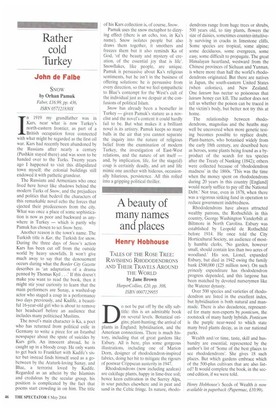A beauty of many names and places
Henry Hobhouse
TALES OF THE ROSE TREE: RAVISHING RHODODENDRONS AND THEIR TRAVELS AROUND THE WORLD by Jane Brown HarperCollins, £20, pp. 308, ISBN 0007129955 Do not be put off by the silly subtitle: this is an admirable book on several levels. Botanical origins; plant-hunting; the arrival of plants in England; hybridisation, and the American connections. There is much history, including that of great gardens like Exbury. All is here, plus some gorgeous illustrations, including one of Marion Dorn, designer of rhododendron-inspired fabrics, doing her bit to mitigate the rigours of postwar Crippsean austerity in 1947.
Rhododendrons (now including azaleas) are calcifuge plants, happy in lime-free soil; hence keen cultivation in the Surrey Alps, in sour patches elsewhere and in peat and sand in the Celtic fringe. In nature, rhodo dendrons range from huge trees or shrubs, 500 years old, to tiny plants, flowers the size of daisies, sometimes counter-intuitively surviving in cracks in limestone cliffs. Some species are tropical, some alpine; some deciduous, some evergreen, some easy, some difficult to propagate. The great Himalayan heartland, westward from the Chinese provinces of Sichuan and Yunnan, is where more than half the world's rhododendrons originated. But there are natives in Japan, the south-eastern United States (when colonies), and New Zealand. One luteum has nectar so poisonous that luteum honey can kill. The author does not tell us whether the poison can be traced in the victim's body, but better not try this at home.
The relationship between rhododendrons, magnolias and the heaths may well be uncovered when more genetic testing becomes possible to replace doubt. Plant-hunters, who botanised widely from the early 18th century, are described here as heroes, some plants being found as a byproduct of the search for tea species after the Treaty of Nanking (1842); others were collected because of 'rhododendron madness' in the 1860s. 'This was the time when the money spent on rhododendrons during 20 years in this country [England] would nearly suffice to pay off the National Debt.' Not true, even in 1878, when there was a vigorous sinking fund in operation to reduce government indebtedness.
Rhododendrons have always attracted wealthy patrons, the Rothschilds in this country, George Washington Vanderbilt at Biltmore in North Carolina. Exbury was established by Leopold de Rothschild before 1914. He once told the City Horticultural Society, an audience of mostly humble clerks, 'No garden, however small, should contain less than two acres of woodland.' His son, Lionel, expanded Exbury, but died in 1942 owing the family bank £500,000 (£25 million now). On such princely expenditure has rhododendron progress depended, and this largesse has been matched by devoted nurserymen like the Waterer dynasty.
Over 500 species and varieties of rhododendron are listed in the excellent index, but hybridisation is both natural and manmade. There is also decadence, represented for many non-experts by ponticum, the rootstock of many hardy hybrids. Ponticum is the purple near-weed to which state many bred plants decay, as in our national parks.
Wealth and/or time, taste, skill and husbandry are essential, represented by the author's list of `Some of the best places to see rhododendrons'. She gives 18 such places. But which gardens embrace which of the 500-plus cultivars that are also listed? It would complete the book, in the second edition, if we were told.
Henry Hobhouse's Seeds of Wealth is now available in paperback (Paperrnac, £10.99).












































































 Previous page
Previous page